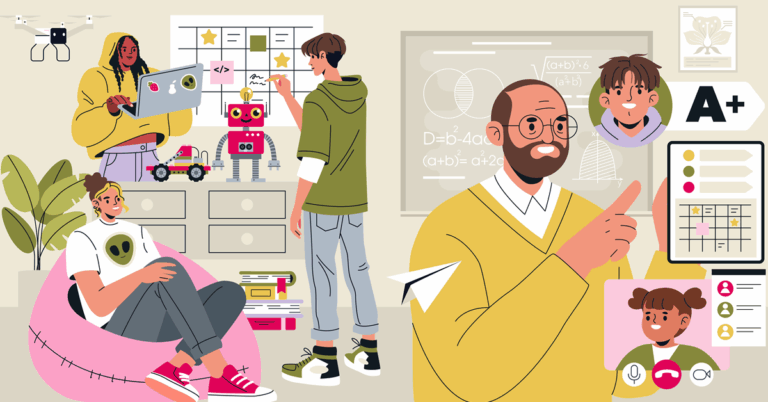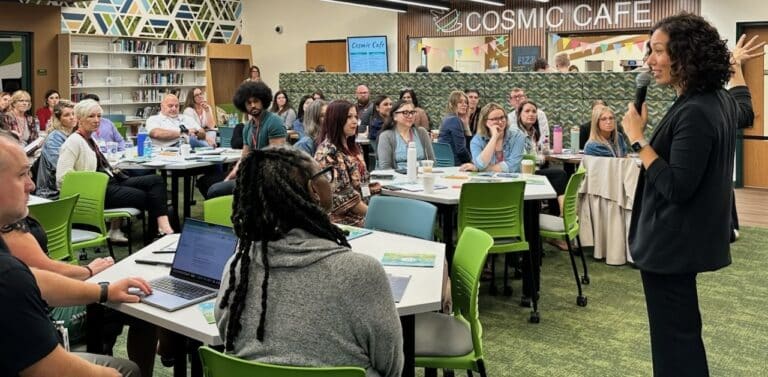The Educator Competencies for Personalized, Learner-Centered Teaching build on and push beyond the best existing teaching competencies and standards to capture what educators need in order to create and thrive in equitable personalized, learner-centered systems. In this second edition of the Educator Competencies, created by KnowledgeWorks, the Council of Chief State School Officers (CCSSO) and the Students at the Center initiative, we are moving toward a vision of how teaching can evolve to meet the changing needs of learners and society.
The competencies are organized into four domains: Intrapersonal, Interpersonal, Cognitive and Instructional. Included under each domain are both high-level competencies and detailed indicators citing specific ways educators can meet each competency in a personalized, learner-centered manner. We also highlight several cross-cutting themes that are instrumental to creating high-quality, personalized, learner-centered environments that produce equitable outcomes.
Our glossary will provide additional clarity with unfamiliar terms.
Intrapersonal Domain
-
Dedication to All Learners fc
Demonstrate a dedication to all learners – especially those historically marginalized and/or least served by public higher education – reaching college, career and civic readiness.
Indicators:
-
Recognize, make transparent, discuss and strive to ameliorate the biases and inequitable distribution of resources that may challenge learners from attaining postsecondary credentials and career advancement. ei
-
Demonstrate awareness of and remedies for unintentional biases, such as lowered expectations of productivity. eirl
-
Be aware of and adept at referring students to an array of services—both inside and out of school—that reduce barriers to learning, social capital and access. eirlse
-
Use restorative practices to drive student learning of social responsibilities, foster respected learning communities and promote inclusion. eise
-
-
Vision for Teaching and Learning fc
Maintain an orientation toward and commitment to a personalized, learner-centered vision for teaching and learning.
Indicators:
-
Be able to explain how personalized, learner-centered education differs from traditional approaches.
-
Place a primacy on building relationships with students that foster their learning success. rlse
-
Understand that student agency means not just providing choice in learning paths, but also knowing when to cede power and step back so that students can lead.
-
Be able to articulate the ways personalized, learner-centered education is especially effective for student groups that have been historically marginalized and/or least served by public higher education. ei
-
-
Practice Growth Mindset fc
Engage in deliberate practices of persistence and a growth mindset.
Indicators:
-
Demonstrate how competence and confidence are gained through effort, assistance and time. rlse
-
Demonstrate the ability to strive toward ambitious, long-term educational and professional goals.
-
Use mistakes, failures and struggles as opportunities for growth. se
-
Model an ability to delay gratification or sustain effort amid challenges and setbacks, to help students understand how to do so. se
-
-
Lifelong Learning and Growth fc
Demonstrate commitment to lifelong professional learning and growth.
Indicators:
-
Model willingness to share reflections on and transparency around successes, failures and challenges. se
-
Seek opportunities to learn new skills, deepen practices and collaborate with others. rl
-
Respond to problems and multiple demands as challenges rather than obstacles. rlse
-
Use data, research, design thinking or other continuous improvement practices for short-cycle reflection or evaluation to examine personal practice, identify student needs, set goals, develop improvement plans, track next steps, share learning with peers and communicate choices to learners, families, other professionals and the community. rl
-
Involve students in reflecting on teaching practices and the learning environment. rl
-
-
Practice Self-Care
Practice and model self-care.
Indicators:
-
Prioritize taking care of one’s own personal, physical, emotional/mental, nutritional and social health and well-being. rlse
-
Create personally safe spaces as needed in order to be mentally and emotionally available for students. se
-
Recognize challenges stemming from personal trauma, trauma-adjacency and/or stress—and adjust appropriately. rlse
-
Have a regular, reflective practice that includes assessing and improving self-care. rlse
-
Interpersonal Domain
-
Positive Learning Environments fc
Design, strengthen and participate in positive learning environments (i.e., school and classroom culture) that support individual and collaborative learning.
Indicators:
-
Contribute to professional learning environments that embrace a culture of question- asking and innovation, cross- or interdisciplinary-teaching and shared accountability for student learning, reflection and self-assessment. rl
-
Contribute to student learning environments that are physically and emotionally safe, welcoming and affirming. eirlse
-
Be equipped and willing to engage colleagues and students when they display micro-aggressions or demonstrate harmful biases. eirlse
-
Deliberately build students’ ability to engage in self-directed learning as well as to learn from peers, especially those of different backgrounds or academic/career trajectories. eirl
-
Be prepared to embody the fundamental features of trauma-informed schools:
- Able to recognize and respond to those who have been impacted by traumatic stress; and eirlse
- Provide students with clear expectations and communication strategies to guide them through stressful situations. rlse
-
-
Build Strong Relationships fc
Build strong relationships with students, peers, identified families and learning community members that contribute to individual and collective success.
Indicators:
-
Develop individual relationships with students that support their social and emotional growth, while setting and maintaining appropriate boundaries. rlse
-
Create collaborative in-school partnerships with peer educators, administrators, content experts and others within the school building that support communities of practice to enhance individual and group student learning. se
-
Build relationships with families, community members, businesspeople and others outside the school to support communities of practice that enhance individual and group student learning, including:
- Open communication channels both online and in person. rlse
- Collaborative partnerships in which each member has a clear role, purpose and value.
-
-
College and Career Access and Success fc
Contribute to college and career access and success for all learners, particularly those who have been historically marginalized and/or least served by public higher education due to background, demographics, neurodiversity or culture.
Indicators:
-
Work to ensure that each student has the access and supports needed to gain the knowledge, master the skills and acquire the credits to succeed in postsecondary education and employment. ei
-
Provide age-appropriate and individualized career exploration, planning and connections counseling to help each student explore, plan and take the necessary steps toward graduating from high school ready for college, career and life.
-
With peers, build and contribute to structures and strategies that foster cultural competency, enact a commitment to equity and are equally supportive of all learners. ei
-
Be explicit with students about the value of positive networks and supportive communities; help students learn how to build networks and engage with communities in order to achieve their academic and career goals. ei
-
-
Increase Responsibility for Student Learning
Seek appropriate individual or shared leadership roles to increase responsibility for student learning and advancement.
Indicators:
-
Share successes and struggles with other educators and actively participate in professional renewal opportunities. rlse
-
Seek or create opportunities to serve as a teacher-leader, mentor, coach or content expert within the school, district or state.
-
Contribute to building and sustaining support across peers for learner-centered approaches. se
-
Build relationships for the purpose of motivating other team members’ performance. se
-
Cognitive Domain
-
Lead Learners Toward Mastery fc
Utilize in-depth understanding of content and learning progressions to engage learners and lead individual learners toward mastery.
Indicators:
-
Build students’ solid understanding of the subject area; identify misconceptions as they arise; and intervene to overcome those misconceptions with individualized scaffolds, richer analysis, varied explanations and/or more targeted forms of practice.
-
Communicate the central concepts, tools of investigation and structures of the content area(s) (e.g., algebra teachers need to know the math—which algebraic concepts are most important, which are foundational and which are more complex; and how to explain the math in multiple ways). rl
-
Create, use or adapt rubrics that clearly define what “mastery” looks like for key, content-based concepts. rl
-
Create learning experiences that make the content-based concepts accessible and meaningful (e.g., enabling students to understand the “why,” as well as the “how”). rl
-
Present content-based concepts (both within and across disciplines) through a variety of perspectives in order to engage learners in critical thinking, creativity, knowledge transfer and collaborative problem-solving related to authentic local and global issues. rl
-
-
Effective Communications
Impart knowledge of the different types of skills involved in effective communication (e.g., written, oral, listening and digital skills and presentation) to develop learners into effective 21st-century communicators.
Indicators:
-
Apply meaningful feedback techniques for learning:
- Provide constructive feedback on communication skills. rl
- Teach students how to give and receive feedback on their own, their peers’ and their educators’ performance—e.g., draft work products, use of learning strategies, etc.
-
Break down the different skills of communication so that students can practice both through content and skill area(s):
- Offer opportunities to demonstrate skills in oral and public communication (with peers and adults), as well as written, listening, online and other skills required for effective communication in the 21st century rl
- Ensure that students understand the standards of discourse and can engage in public/civil discourse, use academic language and conduct argumentation in specific content area(s).
- Whenever possible, ensure that standards and assessments connect to real-world experiences and that communication methods span a variety of media (e.g., not simply reading a book report out loud). rl
-
Stay up to date on digital literacy and age-appropriate engagement, in order to teach students to be savvy and safe consumers of factual and enriching content online. rl
-
-
Culturally Responsive Teaching
Demonstrate awareness of and employ culturally responsive teaching (CRT) to center students’ cultural diversity as a strength and asset in their learning journey
Indicators:
-
Seek structured opportunities for professional development and learning to reflect on equity, civic engagement, education structures and institutions and their intersections. ei
-
Demonstrate ability to:
- Reflect on one’s own race, background, social location and degree of conferred privilege; and ei
- Exhibit an awareness of systemic racism, the various forms of interpersonal oppression and antiracist behaviors. ei
-
Understand how centering students’ cultures and history as “launching pads” for learning improves instruction, particularly for students of color. eirl
-
Be able to integrate aspects of CRT: cultural awareness, information processing, learning partnerships with students and supportive learning environments ei
-
Be able to:
- Identify where one’s own lived experience has shaped one’s own implicit biases; and ei
- Minimize the negative impact of one’s own implicit biases on students. eirl
-
-
Develop Metacognitive Skills fc
Employ techniques for developing students’ skills of metacognition, self-regulation and perseverance.
Indicators:
-
Use modeling, rehearsal and feedback techniques to highlight the processes of thinking, rather than focusing exclusively on the products of thinking. rl
-
Differentiate between behavior and learning outcomes related to self-regulation (ability to control and take responsibility for one’s own focus and effort), rather than perceived ability (belief in one’s capabilities and limits)—and adjust interventions accordingly. rlse
-
Demonstrate familiarity with the concepts of intrinsic versus extrinsic motivation to learn, using a variety of tools that support students’ ability to maintain high expectations for goals over extended periods of time. rlse
-
Know how to help students determine priorities and develop skills for most effectively choosing between/among competing interests. rlse
-
-
De-Center Whiteness
Be able to apply the history of schooling in America and its role in the perpetuation of racism to de-centering Whiteness in the learning community.
Indicators:
-
Identify major stages and historical trends in education and who they were designed to serve – and who not to serve. ei
-
Identify – and if needed, speak out against – the ways structural inequities in schools reinforce White dominance (e.g., grading policies, tracking, seat time, discipline). ei
-
Articulate the connections between personalized approaches to learning and an antiracist stance (e.g., asset-based, recognizing individual strengths, growth mindset, continuous improvement, student agency, authentic assessment). ei
-
-
Stay Current on Practices
Stay up to date on evidence-based practices that inform teaching and learning.
Indicators:
-
Apply the fundamentals of the learning sciences, trauma-informed schools and child and adolescent development to the classroom. eirlse
-
Participate in opportunities to experiment with and assess efficacy of new approaches to foundational elements of learning environments (e.g., flexibility of physical spaces, time, scheduling and extended learning opportunities). rl
-
Seek out and participate in opportunities to learn new developments in curriculum design, instruction and assessment techniques. rl
-
Instructional Domain
-
Mastery Approach fc
Use a mastery approach to learning
Indicators:
-
Customize and scaffold instruction, supports and pacing so that all learners can master the content and fill gaps in understanding. rl
-
Build curriculum units from essential questions, recognized standards, school-wide and/ or subject-specific competencies and/or real-world problems to be solved. rl
-
Determine students’ progress, advancement and pace via various methods of demonstrated understanding of the content, skills and application of learning goals. rl
-
Maintain a focus on high expectations for achievement while providing feedback and opportunities for practice, revision and improvement. rl
-
Integrate many of the other instructional competencies to create a high-quality mastery approach. rl
-
-
Assessment and Data Tools fc
Use assessment and data as tools for learning and to ensure that students are progressing at rates which result in equity of outcomes.
Indicators:
-
Systematically apply the use of data (quantitative and qualitative) to understand individual skills, gaps, strengths, weaknesses, interests and aspirations of each student, and use that information to design and modify personalized learning paths toward meeting school, district and state standards. rl
-
Use multiple, frequent and formative assessments such as self-assessment, exit tickets and student surveys—in a timely manner to engage learners in their own growth, to monitor learner progress, to guide educators’ and learners’ decision making and to communicate with families. rl
-
Facilitate students’ creation of a portfolio, exhibition or other public showcase tool to serve as a culminating event at appropriate educational junctures. rl
-
Develop and use assessment tools that are flexible, involve students in their creation and which clearly articulate standards and criteria for meeting those standards.
-
Collect data that can help expose racial inequities and use that data to ameliorate inequities and close gaps among students, keeping all students to a high standard. ei
-
-
Customize Learning Experiences
Customize the learning experience through assessments, supports, progressions, relationships and technology.
Indicators:
-
Recognize and integrate knowledge of individual learners, diverse cultures and the community context in developing materials and pedagogy to ensure inclusive learning environments that enable each learner to meet rigorous standards. eirl
-
Scaffold, customize whenever possible and provide adequate supports and interventions to appropriately stretch each learner, informed by teacher expertise rl
-
Document and track learning trajectories that meet each learner’s readiness, strengths, needs and interests.
- Update and refine pre-existing individual learning plans or co-design an individual learning plan with each student and identified family as necessary rl
- Use the plan to build effective individual and collective learning experiences.
-
Co-construct and offer choice among multiple means of assessment for students to demonstrate mastery. rl
-
Use technology to find materials, lessen the burden of tracking student progress, engage learners in different ways and offer academic supports. rl
-
-
Promote Student Agency fc
Promote student agency and ownership with regard to learning.
Indicators:
-
Encourage student “voice and choice” via strategies such as:
- Providing access for students to monitor their progress and set goals.
- Enabling students to choose and co-design curricula.
- Providing students with multiple options for demonstrating mastery of a standard or competency in an enduring skill or area.
- Providing opportunities for students to contribute to classroom or school-based decision-making processes, including participatory action research, place-based education, restorative practices and class meetings.
-
Develop students’ abilities to self-reflect and self-regulate via strategies such as goal setting, self-assessment and self-pacing. rlse
-
Develop students’ abilities to collaborate with peers via strategies such as peer assessment and project-based learning. rl
-
Cultivate students’ growth mindsets. se
-
Help students manage their own behavior to optimize the learning environment for all. rlse
-
Support the development of, and positively influence students’ perceptions of, students’ own efficacy, interest and purpose. eise
-
Shift the dynamic from adult control to student agency in decision-making.
-
-
Anytime/Anywhere and Real-World Learning
Provide opportunities for anytime/anywhere and real-world learning that is tied to learning objectives and standards.
Indicators:
-
As described in the interpersonal competencies, build relationships with families, community members, businesspeople and others outside the school to support communities of practice that enhance individual and group student learning.
-
Align out-of-school experiences to the relevant academic competencies or standards so that students have opportunities to demonstrate mastery and receive in-school credit based on out-of-school experiences. rl
-
Demonstrate fluency with the curricular and personal aspects of providing a successful blended learning experience rl
-
Develop diverse physical and digital environments that maximize learning within, across and beyond the classroom(s). rl
-
-
Project Based Learning
Develop and facilitate project-based learning experiences.
Indicators:
-
Engage learners and other faculty in co-designing projects that stretch and deepen the learning experience
-
Use collaborative, cross-curricular projects to develop learners’ deep understanding of content areas, skills and connections to applications beyond school to apply knowledge in meaningful ways.
-
Emphasize regular student reflection about specific questions which draw out the learning within the project.
-
-
Collaborative Group Work
Use collaborative group work.
Indicators:
-
Develop, scaffold, facilitate and where appropriate, co-design collaborative group work.
-
Analyze collaborative group work to ensure that it engages and stretches each learner and builds toward mastery of specific skills, standards or student competencies.
-
Foster students’ ability to identify specific teamwork skills necessary for collaborative group work that are similar to the skills and dispositions necessary for college, career and civic success.
-
Ensure that students have developed the knowledge and skills needed to engage in successful, collaborative group work:
- Clearly define roles, clarifying the purpose of collaborative group work and understanding any assessments.
- Establish and practice techniques for how to share one’s own ideas and how to benefit from the ideas and skills of others.
- Gain practice in tools and techniques such as Socratic questioning and constructive feedback.
-
Plan ways to recognize and address issues of different cultural norms and implicit biases among students when they arise in the context of collaborative group work. ei
-
-
Technology in Service of Learning
Use technology in service of learning.
Indicators:
-
Adopt, adapt and create high-quality digital resources for curriculum. rl
-
Enhance ability to provide real-time assessment and learning-tracking with new digital tools. rl
-
Employ the principles of universal design for learning. eirl
-
Provide opportunities for all students to learn in a digital setting (synchronous and asynchronous). rl
-
Promote the development of students’ digital fluency and their ability to be both safe and discerning when they interact online. rl
-
Assess when technology use in instruction improves engagement, collaboration and learning, and when it does not, and be able to adjust accordingly. rl
-
Promote collaborative and real-world, project-based learning opportunities enhanced with digital tools and content. rl
-




